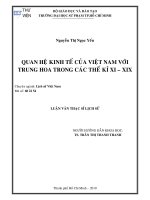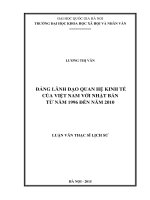Quản trị kinh doanh luôn là một trong những ngành hấp dẫn các bạn trẻ năng động, đặc biệt trong xu thế hội nhập kinh tế Quốc tế của Việt Nam những năm gần đây. Việc tìm hiểu rõ về ngành Quản trị kinh doanh giúp bạn định hướng nghề nghiệp tốt hơn trước kh
Bạn đang xem bản rút gọn của tài liệu. Xem và tải ngay bản đầy đủ của tài liệu tại đây (831.59 KB, 11 trang )
Chapter 16
Leading Change
1
Chapter Objectives
Recognize social and economic pressures for
change in today’s organizations.
Implement the eight-stage model of planned major
change and use everyday strategies for gradual
change.
Use techniques of communication, training and
participation to overcome resistance to change.
Effectively and humanely address the negative
impact of change.
Expand your own and others’ creativity and
facilitate organizational innovation.
2
Ex. 16.1 Forces Driving the Need for Major Organizational
Change
Globalization, technological change, e-business, increased
competition, changing markets
More threats
More domestic competition
Increased speed
International competition
More opportunities
Bigger markets
Fewer barriers
More international markets
More large-scale change in organizations
Reengineering
Horizontal organizing – teams
Networks
Quality programs
New technologies and products
Mergers, joint ventures
Consortia
Virtual and global teams
Strategic change
Cultural change
Learning organization
3
Ex. 16.2 The Eight-Stage Model of Planned Organizational
Change
8. Institutionalize
changes in the
org. culture
1. Establish a
sense of
urgency
7. Consolidate
gains, create
greater change
2. Form a powerful
guiding coalition
3. Develop a
compelling vision
and strategy
4. Communicate
the vision widely
6. Generate
short-term
wins
5. Empower
employees
to act on
the vision
4
Ex. 16.3 A Range of Everyday
Change Strategies
Disruptive
selfexpression
Variable-term
opportunism
Private
Leader working
alone
Public
Leader working
with others
Verbal
Jujitsu
Strategic
alliance-building
5
Personal Compact
The reciprocal obligations and
commitments that define the
relationship between employees
and the organization
6
Downsizing
Intentionally reducing the
size of a company’s
workforce
7
Innovation Terms
Creativity
The generation of new ideas that result in
improved efficiency and effectiveness of the
organization
Idea Incubator
A safe harbor where ideas from employees
throughout the organization can be developed
without interference from company bureaucracy
or politics
8
Innovation Terms (contd.)
Corporate Entrepreneurship
Internal entrepreneurial spirit that includes
values of exploration, experimentation, and risk
taking
Idea Champions
People who passionately believe in a new idea
and actively work to overcome obstacles and
resistance
9
Ex. 16.4 Characteristics of Innovative Organizations and
Creative People
The Innovative Organization
The Creative Individual
Alignment
Commitment
Focused approach
Self-initiated activity
Interdependence
Persistence
Energy
Unofficial activity
Self-confidence
Nonconformity
Curiosity
Diverse stimuli
Open-mindedness
Conceptual fluency
Enjoys variety
Within-company communication
Social competence
Emotionally expressive
Loves people
10
Ex. 16.5 Stages in the Creative
Process
Recognition of
problem/opportunity
Evaluation and
implementation
Information gathering
Insight
Incubation
11









